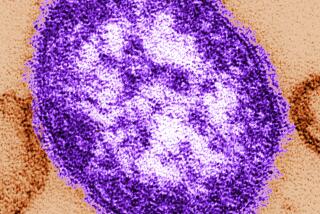Latest measles outbreak highlights a growing problem in California
- Share via
The issue of measles in California suddenly generated national headlines Wednesday thanks to a Disney connection.
A person infected with measles is suspected of visiting Disneyland or Disney California Adventure Park in December after authorities discovered a dozen confirmed and suspected cases, all involving people who attended either of the parks just before Christmas.
Seven confirmed measles patients reside in California, while two live in Utah, the California Department of Public Health said. Three suspected measles cases involve California residents. All went to the Anaheim resort between Dec. 15 and Dec. 20.
Measles has become a growing concern among California health officials. Before the December cases, 2014 was already the worst year of measles cases in California in nearly two decades. Another disease, whooping cough, also known as pertussis, was recorded as having the highest rate in 2014 in this state since 1958.
The rise of these diseases come as a smaller percentage of California’s kindergartners are getting a full set of immunizations by the time they enter school. In 2002, more than 95% of kindergartners in California were fully vaccinated for measles and whooping cough; now, the number is about 92% — low enough to promote the spread of these highly infectious diseases.
Most of the confirmed Disney cases in California involved unvaccinated patients. Six were unvaccinated, including two too young to be inoculated. One had been vaccinated. The confirmed cases among California residents involved young patients, from 8 months old to 21 years.
“If you have symptoms, and believe you may have been exposed, please contact your healthcare provider,” said Dr. Ron Chapman, the state health officer. “The best way to prevent measles and its spread is to get vaccinated.”
Here are some questions and answers about the rise in cases.
Why were there so many cases of measles in California in 2014?
Many of the 61 measles cases in California between January and Oct. 6 were related to unvaccinated residents returning home from the Philippines, where there has been a huge outbreak.
The travelers then infected other Californians. Most of those infected hadn’t been immunized, either because their parents decided against routine childhood vaccinations or because they were too young for the shots, said Dr. Gil Chavez, epidemiologist with the California Department of Public Health.
Is measles something to worry about?
Yes. About 3 out of 10 infected people will get complications like pneumonia, ear infections or diarrhea. Deaths are expected for 1 to 3 children out of every 1,000 who get measles in the United States.
The very young are particularly at risk, such as babies too young to be fully inoculated. In 2008, a 10-month-old boy in San Diego caught the disease in a pediatrician’s waiting room and eventually got a 106-degree fever. According to the U.S. Centers for Disease Control and Prevention, an investigation found that the baby was in the same doctor’s waiting room with another boy who hadn’t been vaccinated and was ill with measles after contracting the disease in another country.
So how infectious is it?
Measles is one of the most contagious diseases known, the CDC says.
For every person infected with measles who enters a completely susceptible, unimmunized population, 12 to 18 people are infected. For severe acute respiratory syndrome, or SARS, the number is 2 to 4. Ebola in West Africa? About 1.5 to 2.5.
Measles spreads through the respiratory droplets that become airborne during a cough or sneeze. “You can catch measles just by being in a room where a person with measles has been — even if the person is gone,” the CDC says.
Are declining immunization rates in California something to worry about?
Yes. Measles vaccination is very important because a very high percentage of the population, 90% to 95%, must be immune to eliminate ongoing infections, Chavez said.
“The current pertussis and measles outbreaks in the state are perfect examples of the consequences and costs to individuals and communities when parents choose not to vaccinate their children,” Chavez said.
Measles ravaged California from 1989 to 1990, when more than 15,000 cases were reported, causing about 70 deaths in the state. That outbreak prompted health authorities to recommend a second dose to the measles vaccine schedule.
“For every 500 cases, there will be a death, and there will be two cases of encephalitis — inflammation of the brain — and many of those will end up with permanent brain damage,” said Dr. James Cherry, a UCLA pediatric infectious diseases expert.
What about whooping cough?
There were more than 9,900 cases of whooping cough in California in 2014 through Nov. 26, meaning for every 100,000 Californians, there were 26 cases of the disease. The last time the rate reached 26 was in 1958. (Health officials use the infection rate per 100,000 residents to make comparisons with the 1950s to account for the growth in the state’s population.)
What’s causing whooping cough to return?
Chavez says that although measles vaccine confers lifelong immunity, that’s not the case for the inoculation for whooping cough and it becomes less effective over time. That’s why whooping cough cases spike every three to five years, explaining why there were bad years for whooping cough in 2005, 2010 and 2014.
Is whooping cough something to worry about?
Yes, it is deadly for infants less than 4 months old, who are vulnerable until they can get their first doses of the vaccine. Experts recommend a booster dose of the pertussis vaccine, known as Tdap, for anyone above the age of 11 who has never received that inoculation. Tdap was introduced in 2005.
Two babies less than 2 months old became infected with whooping cough in 2013 and died in 2014. A 5-week-old baby was infected in 2014 and died in California the same year.
State officials urge pregnant women to receive the whooping cough vaccine during the last trimester of pregnancy to protect newborns.
What are the symptoms of these diseases?
Measles starts with fever, then coughing, runny nose, redness of eyes, and finally a rash that begins on the head and spreads to the rest of the body, the CDC says. A high fever can persist, the rash can last for as long as a week and coughing can continue for about 10 days.
Whooping cough starts with cold-like symptoms, and perhaps a cough or fever, and then causes uncontrollable, violent coughing that can make it hard to breathe. In infants, the cough can be minimal or absent; instead, the disease can pause the baby’s breathing.
Isn’t measles a disease of the past?
Measles is still a big problem in Western Europe, Pakistan, Vietnam and the Philippines, and unvaccinated travelers can bring the disease back to the United States, state officials say.
What can I do to make sure I’m immunized for measles?
Ask your doctor to get a test to check for measles immunity or get vaccinated. Inoculations for measles have been available in the United States since 1963, and two doses have been recommended since 1989.
Why are fewer children getting vaccinated?
An anti-vaccination movement is being driven by parents who question the medical consensus that inoculations are safe. Some are concerned that vaccines could trigger autism, which has been thoroughly discredited by scientists.
In Los Angeles County, schools with high clusters of unvaccinated kindergartners were most prominent in wealthy coastal and mountain communities, a Times analysis found.
What’s the measles outlook for the rest of the United States?
Problematic. From Jan. 1 to Nov. 29, there were 610 cases of measles nationwide — the highest number of cases since measles was declared eliminated in the United States in 2000. That means measles is no longer native to this country but can still be a problem when travelers bring it in. In 2013, there were fewer than 200 measles cases.
Twitter: @ronlin
More to Read
Sign up for Essential California
The most important California stories and recommendations in your inbox every morning.
You may occasionally receive promotional content from the Los Angeles Times.











